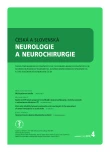Intracranial stenosis – the best conservative treatment should be combined with a stent - YES
Authors:
doc. MUDr. Kamil Zeleňák, Ph.D.
Authors‘ workplace:
Rádiologická klinika JLF UK a UNM Martin
Published in:
Cesk Slov Neurol N 2019; 82(4): 367
Category:
Controversions
Sources
1. van den Wijngaard IR, Holswilder G, van Walderveen MA et al. Treatment and imaging of intracranial atherosclerotic stenosis: current perspectives and future directions. Brain Behav 2016; 6(11): e00536. doi: 10.1002/brb3.536.
2. Kasner SE, Chimowitz MI, Lynn MJ et al. Predictors of ischemic stroke in the territory of a symptomatic intracranial arterial stenosis. Circulation 2006; 113(4): 555–563. doi: 10.1161/CIRCULATIONAHA.105.578229.
3. EC/IC Bypass Study Group. Failure of extracranial-intracranial arterial bypass to reduce the risk of ischemic stroke. Results of an international randomized trial. N Engl J Med 1985; 313(19): 1191–1200. doi: 10.1056/NEJM198511073131904.
4. Mori T, Fukuoka M, Kazita K et al. Follow-up study after intracranial percutaneous transluminal cerebral balloon angioplasty. AJNR Am J Neuroradiol 1998; 19(8): 1525–1533.
5. Zeleňák K, Kurča E, Vyletelka J et al. Kombinácia CAS s cerebrálnou protekciou a intrakraniálnej PTA. Slovenská rádiológia 2004; 11(1): 24–27.
6. Yu W, Jiang WJ. Stenting for intracranial stenosis: potential future for the prevention of disabling or fatal stroke. Stroke Vasc Neurol 2018; 3(3): 140–146. doi: 10.1136/svn-2018-000158.
7. Zaidat OO, Fitzsimmons BF, Woodward BK et al. Effect of a balloon-expandable intracranial stent vs medical therapy on risk of stroke in patients with symptomatic intracranial stenosis: the VISSIT randomized clinical trial. JAMA 2015; 313(12): 1240–1248. doi: 10.1001/jama.2015.1693.
8. Chimowitz MI, Lynn MJ, Derdeyn CP et al. Stenting versus aggressive medical therapy for intracranial arterial stenosis. N Engl J Med 2011; 365(11): 993–1003. doi: 10.1056/NEJMoa1105335.
9. Chimowitz MI, Lynn MJ, Turan TN et al. Design of the stenting and aggressive medical management for preventing recurrent stroke in intracranial stenosis trial. J Stroke Cerebrovasc Dis 2011; 20: 357–368. doi: 10.1016/j.jstrokecerebrovasdis.2011.05.001.
10. Fiorella D, Derdeyn CP, Lynn MJ, et al. Detailed analysis of periprocedural strokes in patients undergoing intracranial stenting in Stenting and Aggressive Medical Management for Preventing Recurrent Stroke in Intracranial Stenosis (SAMMPRIS). Stroke 2012; 43: 2682–2688. doi: 10.1161/STROKEAHA.112.661173.
11. Yu W, Jiang WJ. Stenting for intracranial stenosis: potential future for the prevention of disabling or fatal stroke. Stroke Vasc Neurol 2018; 3(3): 140–146. doi: 10.1136/svn-2018-000158.
12. Krajíčková D, Krajina A, Lojík M et al. Periprocedural risk and long-term outcome of intracranial angioplasty based on a single-centre experience. Vasa 2013; 42(4): 264–274. doi: 10.1024/0301-1526/a000287.
13. Salik AE, Selcuk HH, Zalov H, et al. Medium-term results of undersized angioplasty and stenting for symptomatic high-grade intracranial atherosclerotic stenosis with Enterprise. Interv Neuroradiol 2019; 16: 1591019919832244. doi: 10.1177/1591019919832244.
14. Du Z, Mang J, Yu S et al. Weighing in on the off-label use: initial experience of neuroform ez stenting for intracranial arterial stenosis in 45 patients. Front Neurol 2018; 9: 852. doi: 10.3389/fneur.2018.00852.
15. Alexander MJ, Zauner A, Chaloupka JC et al. WEAVE trial: final results in 152 on-label patients. Stroke 2019; 50(4): 889–894. doi: 10.1161/STROKEAHA.118.023996.
16. Gao P, Wang D, Zhao Z et al. Multicenter prospective trial of stent placement in patients with symptomatic high-grade intracranial stenosis. AJNR Am J Neuroradiol 2016; 37(7): 1275–1280. doi: 10.3174/ajnr.A4698.
17. Miao Z, Zhang Y, Shuai J et al. Thirty-day outcome of a Multicenter Registry study of stenting for symptomatic intracranial artery stenosis in China. Stroke 2015; 46(10): 2822–2829. doi: 10.1161/STROKEAHA.115.010549.
18. Ma N, Zhang Y, Shuai J et al. Stenting for symptomatic intracranial arterial stenosis in China: 1-year outcome of a multicentre registry study. Stroke Vasc Neurol 2018; 3(3): 176–184. doi: 10.1136/svn-2017-000137.
19. Zhang Y, Rajah GB, Liu P et al. Balloon-mounted versus self-expanding stents for symptomatic intracranial vertebrobasilar artery stenosis combined with poor collaterals. Neurol Res 2019: 1–10. doi: 10.1080/01616412.2019.1610837.
Labels
Paediatric neurology Neurosurgery NeurologyArticle was published in
Czech and Slovak Neurology and Neurosurgery

2019 Issue 4
- Metamizole vs. Tramadol in Postoperative Analgesia
- Memantine in Dementia Therapy – Current Findings and Possible Future Applications
- Memantine Eases Daily Life for Patients and Caregivers
- Metamizole at a Glance and in Practice – Effective Non-Opioid Analgesic for All Ages
- Advances in the Treatment of Myasthenia Gravis on the Horizon
Most read in this issue
- Multiple system atrophy
- Superior semicircular canal dehiscence
- Spina bifida in the Czech Republic – incidence and prenatal diagnostics
- Hearing loss after spinal anesthesia
